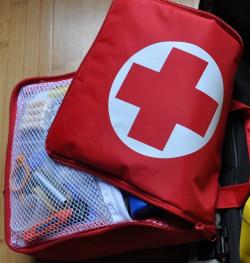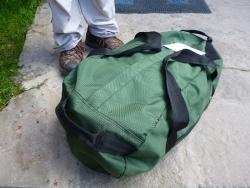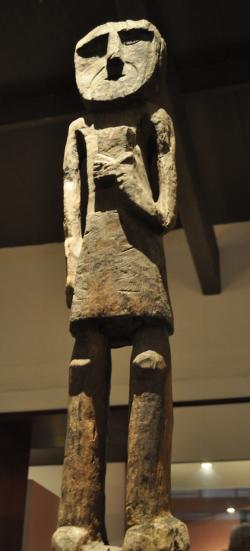We've seen your emails. We know you have questions about logistics, porters and altitude. Here are the most popular:
Will I get altitude sickness when I arrive in Cusco?
It's common for most people coming from sea level to experience at least mild symptoms of altitude sickness when they arrive in Cusco, which is 11,000 ft/3430 m above sea level. Symptoms vary from person to person, but can include:
is 11,000 ft/3430 m above sea level. Symptoms vary from person to person, but can include:
- headache
- nausea
- insomnia
- fatigue
- loss of appetite.
Treatments may include:
- OTC pain reliever - bring your own favorite remedy for pain relief
- Oxygen. Most hotels have oxygen tanks in their lobbies and guides will carry small tanks of oxygen on hikes. Some local pharmacies sell an individual size O2 tank for personal use.
- Coca Leaf. Locals believe that drinking coca leaf tea will help and you will find the tea leaves readily available in hotel tea bars as well as restaurants.
- Water. Drink extra to keep your blood flowing freely. Dehydration leads to sludgy blood and may contribute to your discomfort.
- Diamox. (a vaso-dilator medication) can be purchased by prescription in some western countries or over the counter in Peruvian pharmacies. You need to take it 2 Day before arriving at altitude.
Treatments may alleviate the symptoms as you adjust in the first 12-48 hours. But you cannot expect the sense of breathlessness to completely disappear, no matter how you treat it. If symtoms do not show signs of improvement within 24 hours of your arrival, please notify your travel companions or guide so s/he can monitor your progress. In rare occasions, individuals may need to seek medical attention.
Is it safe to drink the water?
Tap water in Lima, Cusco and other larger cities is consumed by local people every day. But is it safe for you? There's only one way to find out and we suggest that you not drink the tap water or use it to brush your teeth. Bottled water is cheap and available everywhere including small towns and villages. We support Travelers Against Plastic to reduce the use of disposable water bottles and encourage you to bring a purification device to make your own safe drinking water. The device should be rated to purify water from microbes and viruses, not just for taste. Purified drinking water is provided on all the multi-day hikes and during your stay in the Amazon jungle lodges. At the very least you can bring a reusable water bottle and buy large bottles of drinking water to refill.
What equipment do you provide for hikes?
 Porters will carry tents for sleeping, cooking, dining & urinating (we provide a special tent for "pee pee" which has biodegradable toilet for #1. We could call it the "girls'" tent, but we won't). And we provide all kitchen and cooking supplies including the food that is served. We do not provide sleeping bags, trekking poles or big, fluffy pillows. With advance notice, sleeping bags can be rented for $20 pp. Trekking poles are available to rent for $20 pp for multi-day hikes and $8 pp for 1 day hikes. Our sleeping bags are Sierra Designs and North Face mummy bags rated to 20 degrees or 30 degrees F. If you choose to rent a sleeping bag, we ask you to provide your own bag liner. We also provide Therma-rest Basecamp regular-size mattresses. If you are over 6' 4/190 cm, please bring your own mattress or let us know & we'll tape 2 mattresses end to end (just kidding - like the big, fluffy pillows).
Porters will carry tents for sleeping, cooking, dining & urinating (we provide a special tent for "pee pee" which has biodegradable toilet for #1. We could call it the "girls'" tent, but we won't). And we provide all kitchen and cooking supplies including the food that is served. We do not provide sleeping bags, trekking poles or big, fluffy pillows. With advance notice, sleeping bags can be rented for $20 pp. Trekking poles are available to rent for $20 pp for multi-day hikes and $8 pp for 1 day hikes. Our sleeping bags are Sierra Designs and North Face mummy bags rated to 20 degrees or 30 degrees F. If you choose to rent a sleeping bag, we ask you to provide your own bag liner. We also provide Therma-rest Basecamp regular-size mattresses. If you are over 6' 4/190 cm, please bring your own mattress or let us know & we'll tape 2 mattresses end to end (just kidding - like the big, fluffy pillows).
We provide duffle bags for multi-day hikes.
How do I know if I'll need an extra porter for my hike?
All multi-day hikes with Adios Adventure Travel include 2 porters per hiker. This is our standard. We do this as much for the porters as for the hikers. One way to protect porters from abuse is to ensure that there are enough porters to distribute the load. And another way to show appreciation for porters is to pay them living wages. Which we do. It's customary to tip porters about $30 each after the hike. You are free to tip any amount you can afford.
Should I travel to South America if I have a life-threatening allergy?
We've learned that there are different kinds of allergies; from hayfever to insect stings. IF YOU HAVE A LIFE-THREATENING ALLERGY TO ANY FOOD, INSECT, MEDICATION OR NATURAL ELEMENT, WE REQUIRE WRITTEN, ADVANCE NOTICE WITH FULL DESCRIPTION OF THE ALLERGEN AND THE TREATMENT. We reserve the right to require a doctors written approval for you to travel or ask you to provide your own treatment remedy and plan. And we ask you to notify your guide during your first meeting. In rare circumstances we may choose to reject your reservation if we feel that your condition is beyond the scope of the training of our guides or negatively impact other travelers.
What is the best way to travel between Lima and Cusco?
We recommmend flying between the cities because other means requires more time or is not practical for short vacations. There is no train service between Lima and Cusco. And while there is bus service, the drive is almost 24 hours long over paved, but winding mountain roads. There is no speedy highway. The cost of round-trip air tickets varies from around $250 pp on the domestic carriers, including SKY and PERUVIAN AIRLINES, to $385 pp on LAN AIRLINES and somewhere in-between on AVIANCA AIRLINES.
The majority of the flights between the cities occurs in the morning to mid-day hours. Afternoon flights taper off by 5 pm and there are no evening flights in either direction due to mountain weather conditions.
Where should I stay if my international flight arrives in Lima in the evening?
There is only one hotel at the Lima airport. The Wyndham Costa del Sol is connected to the arrivals terminal by a skybridge on the 2nd floor. It takes literally 2 minutes to walk from the terminal to the lobby of the hotel. The hotel is expensive by Peruvian standards (in excess of $250 per double room per night). We have found cheaper rates by calling their toll free number 877-999-3223 or booking on Expedia or Orbitz. The hotel will accommodate as many as 3 to a room, but not 4.
2 minutes to walk from the terminal to the lobby of the hotel. The hotel is expensive by Peruvian standards (in excess of $250 per double room per night). We have found cheaper rates by calling their toll free number 877-999-3223 or booking on Expedia or Orbitz. The hotel will accommodate as many as 3 to a room, but not 4.
This hotel is best for groups who arrive in Lima late evening and plan to depart again by air the next day. For groups planning to stay in Lima, it's best to pre-arrange a transfer to a hotel outside the airport, unless you don't mind paying the "gringo rate" when you negotiate a taxi on your own. The travel time is about 45 minutes each way when the traffic is moderate. And the cost ranges from $35 each way and up. If your group is larger than 3 persons, you may need a transfer in a mini-van or two taxis.
Do I need vaccinations to visit Machu Picchu?
The altitude of Machu Picchu is 8000 ft/2440 m and higher. Disease-carrying vectors do not thrive at higher elevations. US passport holders are not required to get Yellow Fever vaccinations or prophylactic Malaria treatments. Although there have been no recent cases of Yellow Fever in Peru, some countries, including the US, recommend that visitors get Yellow Fever vaccinations prior to visiting the Amazon Rainforest including Tambopata Reserve or Manu National Reserve. We recommend that travelers check the regulations for re-entry for any countries they will pass through after leaving Peru, Bolivia or Ecuador. Bolivia requires all foreigners to have proof of yellow fever vaccination upon entry. (Australians are required to get yellow fever vaccination if they enter Peru, even if they are only visiting the higher elevations)

